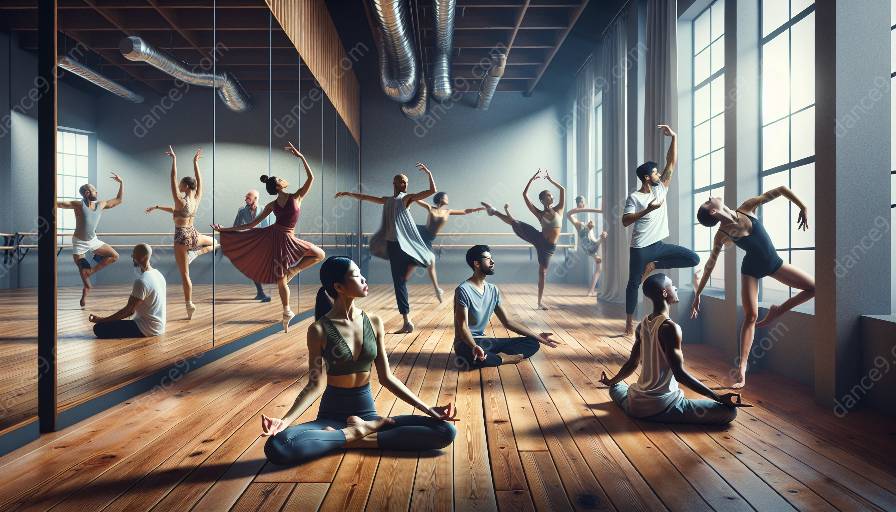Mindfulness and Dance: A Harmonious Partnership
For dancers, the interplay between mindfulness and resilience profoundly impacts stress management and overall well-being. Mindfulness, the practice of cultivating awareness and attention in the present moment, fosters resilience and equips dancers with essential tools for managing the physical and mental rigors of their art. This comprehensive guide explores the ways in which mindfulness contributes to dancers' resilience and stress management while nurturing their physical and mental health.
Dance, Stress, and Resilience
Dance, an art form that demands physical and mental discipline, often exposes practitioners to significant stressors. Whether it's the pressure of performing flawlessly, the strain of rigorous training, or the psychological challenges of a competitive industry, dancers face a myriad of stress-inducing factors. In such a demanding environment, resilience becomes a vital asset. Resilience, defined as the ability to adapt and bounce back from adversity, is crucial in sustaining a dancer's well-being and performance. Mindfulness plays a pivotal role in nurturing resilience by providing dancers with a mental fortitude that enables them to confront and conquer stressors. Through the practice of mindfulness, dancers develop a heightened awareness of their thoughts and emotions, allowing them to effectively manage stress and build resilience in the face of challenges.
Mindfulness in Practice: Embracing the Present Moment
When dancers engage in mindfulness, they immerse themselves in the present moment, fostering a deep connection between mind and body. This heightened awareness allows dancers to effectively manage stress by acknowledging and addressing sources of tension, anxiety, or self-doubt. By embracing mindfulness, dancers learn to navigate the physical and mental demands of their craft with grace and confidence, cultivating resilience in the process. Moreover, the cultivation of mindfulness facilitates an enhanced mind-body connection, which supports dancers in preventing injuries, optimizing performance, and fostering overall well-being.
Physical and Mental Health in Dance: The Mindfulness Advantage
Mindfulness contributes significantly to the improvement of dancers' physical and mental health. Physically, mindfulness aids in injury prevention by promoting body awareness, proper alignment, and enhanced movement mechanics. Mentally, the practice of mindfulness empowers dancers to navigate anxiety, performance pressure, and self-criticism, fostering psychological resilience and emotional well-being.
The Impact of Mindfulness on Stress Management
Mindfulness serves as a potent tool for stress management among dancers. By cultivating a mindful approach, dancers can effectively alleviate the physical and mental strain brought about by the demands of their profession. Through mindfulness practices such as meditation, deep breathing exercises, and mindful movement, dancers learn to regulate their stress responses, enhancing their capacity to cope with the challenges and uncertainties inherent in the dance world. Furthermore, mindfulness equips dancers with the skills to cultivate a positive mindset, enhance emotional regulation, and foster a sense of calm amidst the pressures they face, thereby fortifying their resilience and bolstering their overall well-being.
Cultivating Mindfulness in Dance Training
Integrating mindfulness practices into dance training programs is fundamental in nurturing resilience and stress management. By incorporating mindfulness techniques, educators and choreographers can instill in dancers the tools for self-awareness, emotional regulation, and stress mitigation. Mindful movement, focused breathing exercises, and body scanning techniques are examples of how mindfulness can be integrated into dance training, providing dancers with the means to enhance their resilience, maintain peak performance, and sustain their physical and mental health.
Embracing mindfulness in the context of dance not only enriches dancers' experiences but also equips them with indispensable tools for resilience and stress management. By cultivating awareness, presence, and resilience through mindfulness, dancers are better prepared to navigate the challenges of their art while safeguarding their physical and mental well-being. The symbiotic relationship between mindfulness, resilience, and stress management forms a powerful foundation for dancers, enabling them to thrive in an environment that demands unwavering physical and mental strength.


































